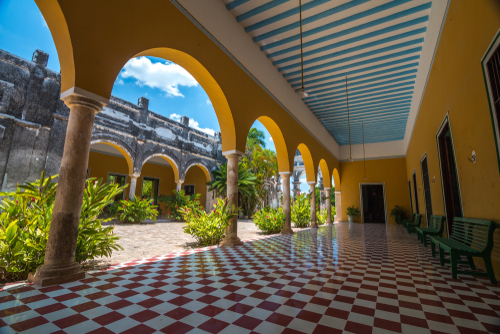Exploring Mexico’s traditional homes provides a glimpse into its rich history and diverse cultural heritage. Architectural styles in Mexico reflect the influence of ancient civilisations, colonial rule, and the ingenuity of local craftsmen. From the grandeur of haciendas to the functional simplicity of adobe homes, each type of traditional Mexican house tells a unique story.
If you’re based in the UAE and are curious to learn more about the history and types of traditional homes in Mexico, this blog will guide you through their distinctive characteristics, cultural importance and how they evolved over time.
An Overview of Traditional Homes in Mexico
Traditional Mexican homes are a blend of history, culture, and functionality. They are influenced by indigenous styles, European colonisation, and regional climates. These homes were built with locally available materials, showcasing resourcefulness and a deep connection with nature. The architectural designs are not just visually striking; they are also a testament to Mexico’s historical and cultural transformation.
The following sections will discuss the key types of traditional homes you might find in Mexico, from ancient eras to modern adaptations, highlighting the history behind their designs and construction methods. The following sections will discuss the key types of traditional homes you might find in Mexico, from ancient eras to modern adaptations, highlighting the history behind their designs and construction methods.
Types of Traditional Homes in Mexico
Adobe Houses
Adobe houses are among the most iconic traditional homes in Mexico. Built using sun-dried bricks made from clay, water, and straw, these homes have been a staple of Mexican architecture for centuries.
Key characteristics of adobe houses:
- Materials: Adobe bricks were readily available and cheap to produce, making them ideal for building in rural regions with limited resources.
- Design: Homes were typically single-storey with flat roofs, designed to keep interior spaces cool in hot climates.
- Cultural significance: Adobe houses can be traced back to indigenous communities, such as the Zapotecs and Mixtecs, who used similar techniques before the arrival of Europeans.
Haciendas
The hacienda is one of the grandest symbols of colonial Mexico. These sprawling estates were primarily built during the Spanish colonisation period for farming, livestock, or as centres for trade.
Key characteristics of haciendas:
- Architecture: Haciendas were designed with large courtyards, arched corridors, and thick stone walls for protection and durability.
- Materials: They incorporated stone, wood, and terracotta tiles into their construction, blending Spanish and indigenous influences.
- Lifestyle: These estates often housed the landowners and workers, doubling as residences and operational hubs. Some haciendas have now been restored into luxury hotels that attract visitors from around the world.
Palapas
A palapa is an open-sided shelter with a roof made of dried palm leaves, commonly found in tropical coastal regions. These homes are perfect for warm climates and remain a vital part of traditional Mexican design.
Key characteristics of palapas:
- Design: Palapas were constructed with simple, lightweight wooden frames and palm-thatched roofs that were resistant to heat and rain.
- Purpose: They are often used as outdoor living areas or extensions of homes, offering a breezy and relaxing space.
- Cultural connection: Palapas highlight the traditional resourcefulness of coastal communities, who used naturally abundant materials to create practical, comfortable structures.
Pueblo Homes
Pueblo-style homes are most associated with the northern regions of Mexico and areas close to the US-Mexico border. This style has its roots in the indigenous architecture of native pueblos.
Key characteristics of pueblo homes:
- Materials: These homes often used adobe or stucco walls painted in earthy tones.
- Design: Pueblo homes featured rounded corners, flat roofs, and wooden beams protruding through the exterior.
- Cultural roots: This distinct style is closely tied to the traditions of native tribes such as the Puebloans.
Mexican Colonial Houses
Colonial homes represent the architectural influence left behind by the Spanish. Found in urban centres like Mexico City or Puebla, these homes combine traditional indigenous elements with European design.
Key characteristics of colonial houses:
- Elegance: They often included ornate balconies, decorative tile work, and large wooden doors.
- Layout: Colonial homes had central courtyards that served as the heart of family life.
- Enduring popularity: Many traditional colonial houses are preserved in Mexico’s historic city centres today, offering a glimpse into the region’s European-inspired past.
Modern Adaptations of Traditional Homes
While traditional Mexican architecture was born out of necessity and functionality, today’s adaptations incorporate modern materials and amenities while preserving cultural roots. For instance, contemporary designers may use concrete instead of adobe, but still integrate traditional elements such as courtyards, tile accents, and natural materials.
Preserving the Legacy of Traditional Mexican Homes
Traditional homes in Mexico are more than just places to live; they represent the nation’s history and cultural identity. Their enduring popularity highlights the desire to preserve the architectural styles that have shaped the country for centuries.
Restorations, eco-friendly updates, and even modern reinterpretations of these homes are efforts to keep this legacy alive. For travellers coming from the UAE, visiting these homes or staying in restored haciendas or pueblo-style accommodations can be a fascinating way to immerse yourself in Mexican culture and history.
FAQ Section
What is the most iconic type of house in Mexico?
The adobe house is one of the most iconic types of traditional Mexican homes, known for its simple and functional design.
Are haciendas still in use today?
Yes, many haciendas have been restored and repurposed as boutique hotels or tourist attractions, allowing visitors to experience their historic charm.
Why is traditional Mexican architecture important?
Traditional architecture in Mexico reflects the country’s cultural, historical, and environmental heritage. It connects generations and preserves time-honoured building techniques.
Do modern homes in Mexico incorporate elements from traditional homes?
Absolutely. Many modern homes adapt traditional designs by integrating courtyards, arches, and natural materials while leveraging contemporary construction methods.
Can I visit or stay in traditional homes in Mexico?
Yes, many traditional homes, such as haciendas and colonial houses, have been converted into accommodations or museums that welcome visitors.
